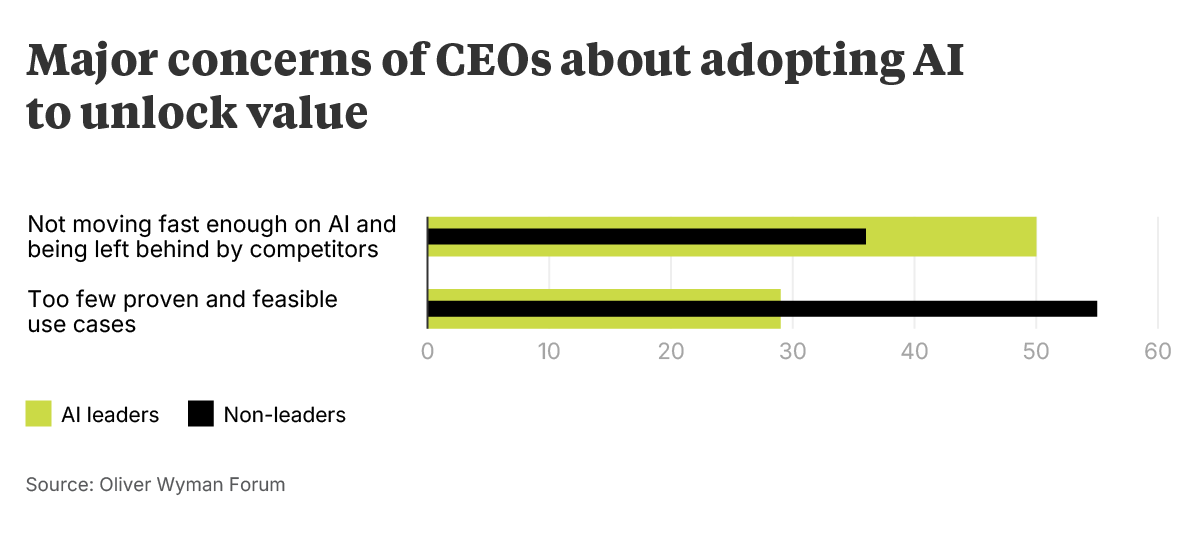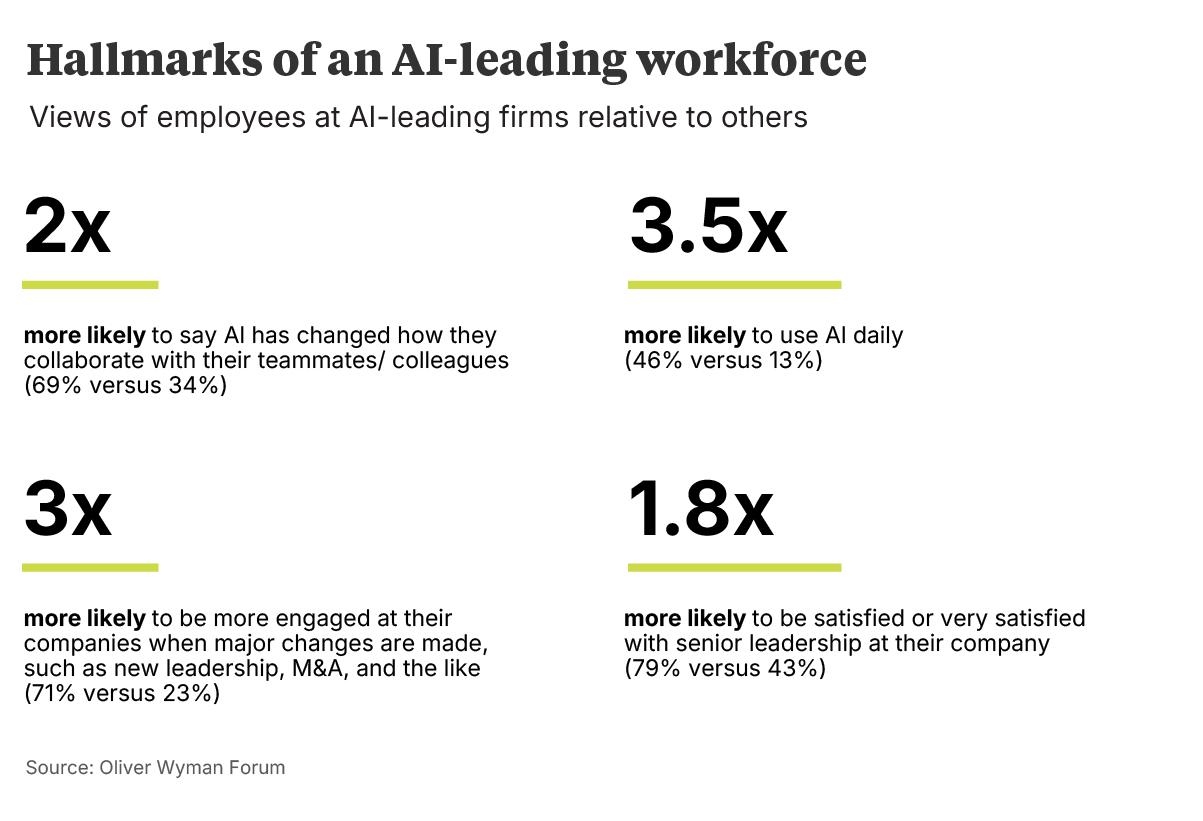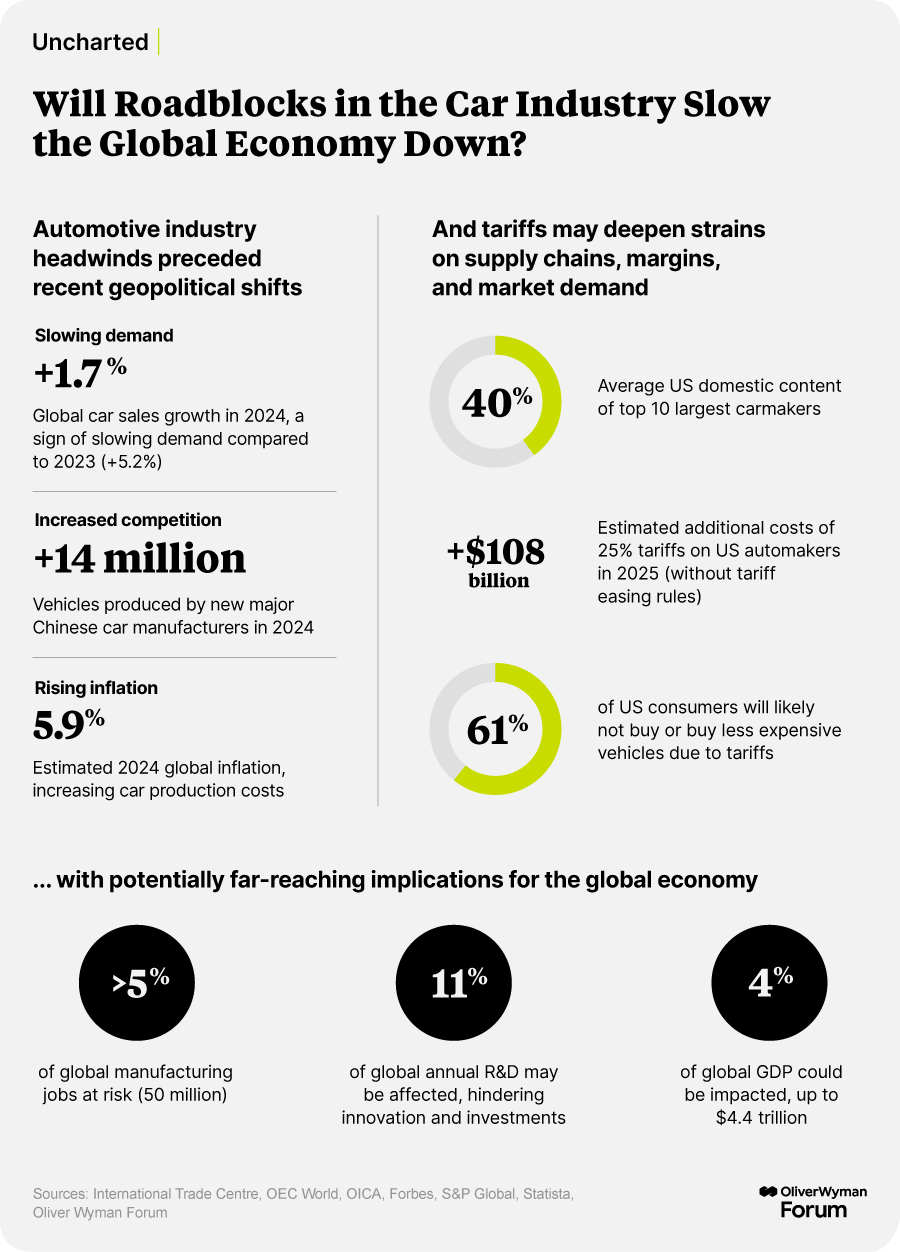By John Romeo
What have you been doing the past year? An innocuous question for an old acquaintance, perhaps, but a priority for today’s business leaders given the breakneck pace of technological advances.
Just a year ago virtually no one had heard of DeepSeek, the Chinese artificial intelligence (AI) company that sent shock waves through Silicon Valley when it disclosed the power of its low-cost AI model, or suggested investing $500 billion in AI infrastructure, as several companies have announced plans to do. Most leaders today are aware of the importance of AI for the future of their business. But as our research reveals (see the next story), only 17% are moving with the speed and determination to generate significant returns from the technology. The challenge for most is how to meaningfully step up the pace of change.
In today’s environment, if you’re not operating differently — using AI agents, acquiring new capabilities, upskilling your workforce, fundamentally rethinking the way you deliver products and services — you risk falling behind.
This pace of disruption will vary across industries, but the leading edge will be activities that are driven by information and data. Take finance, for example. Firms crunch masses of data to forecast growth, track cash flows, and estimate rates of return across companies and sectors to make investment decisions. The sector has been a pioneer in adopting technology from the telegraph to the mainframe. AI will be no different except for the speed at which it’s likely to shake up the established hierarchy and spawn a new generation of leaders that deliver banking, investment, and insurance products in entirely new ways.
AI is forcing leaders to make consequential business decisions at a pace that would have seemed reckless just a few years ago. To succeed, they will need to go further and faster than they would have done in the past, planning with some end vision in mind while standing ready to course correct quickly if circumstances change or investments don’t pan out.
The AI race is a decathlon, not a sprint, and leaders may not even know the order of events. No one said it would be easy.
John Romeo is CEO of the Oliver Wyman Forum
Two and a half years after ChatGPT burst on the scene, artificial intelligence (AI) is developing so fast that most companies struggle to keep up. Yet a corporate vanguard is showing how to deliver real value by moving with pace and ambition to adopt the technology — and bringing their workforce along for the ride.
The latest Oliver Wyman Forum survey of CEOs of New York Stock Exchange-listed companies found that 17% of companies reported revenue or cost improvement of more than 10% from AI initiatives. Their progress to date suggests some early lessons, including that speed creates value and that reaping big gains from AI requires fundamental business transformation.
Workers, meanwhile, have their own views of what AI leadership looks like. Employees who identify their companies as AI leaders are much more likely than others to have received formal training in the technology, to use it daily, and to feel involved in AI transformation and comfortable that their jobs are secure, according to Oliver Wyman Forum’s latest global employee survey.
The takeaway from these findings: An engaged and confident workforce is essential for any CEO looking to transform their business with AI.
Speed creates value
There is much we don’t yet know about AI’s ultimate impact on the business environment, but what sets leaders apart is their willingness to take decisive action rather than waiting for perfect clarity. CEOs of AI leaders are much more concerned about not moving fast enough and being left behind by competitors than they are by a lack of proven and feasible use cases, which is diametrically opposite from the views of other CEOs. No one wants to be stuck in pilot purgatory at a time of accelerating change.

This approach is already delivering real returns. Eighty-six percent of AI-leading CEOs cite some level of tangible revenue impact, with one in three generating more than 20% of revenue from AI-enabled products and services. By contrast, only 34% of non-leader CEOs reported some measurable revenue impact from AI, and none of them exceed 10%.
Leaders seek to transform, not tweak
Tactical uses of AI may deliver tangible returns in specific use cases but enterprise-level value that can reshape business models and provide sustainable competitive advantage requires comprehensive efforts to combine technology with new ways of working and developing products and services. This is where CEOs of AI leaders distinguish themselves.
Nearly half of AI leaders (46%) cited long-term business transformation and technology and AI among their top three priorities for creating shareholder value in the next two years. By contrast, only 26% of non-leaders ranked business transformation as a top priority and 29% attached a similar importance to tech and AI. Just as notable is how leaders are aligning their short-term efforts with long-term objectives. Fully 71% of AI leaders ranked technology and AI as a force that will have the biggest impact on competitiveness over the next five to 10 years, compared with just 45% of non-leaders.
Turning employees into change agents
Business leaders can spend millions on AI technology and months planning strategy and implementations but ignore a critical success factor: their own people. The two camps are more aligned than you might think, though. Smart CEOs can turn their workers into transformation multipliers.
Employees who identify their companies as AI leaders are much more likely as others to have received formal AI training, to use AI daily, and to say AI has transformed collaboration with colleagues.

Those advantages, in turn, bolster employee confidence and organizational morale. Employees who consider their firms as AI leaders are much more likely than others to be satisfied with senior leadership, to feel assured their jobs will be protected during AI implementation, and to feel engaged at their companies during times of change.
We don’t yet know how AI might affect demand for various job roles and labor at a macro level, but organizations that create confident and AI-capable employees may be building the ultimate strategic asset: A workforce that embraces change, drives innovation, and accelerates transformation. That’s what every company should be looking to develop at a time when competitive advantage increasingly flows from organizational agility and innovation speed.
The speed and power of generative AI have made it a weapon of choice for cyber criminals that can overwhelm conventional defenses. Yet those same attributes make generative AI an essential part of any organization’s cybersecurity, according to a recent paper by Oliver Wyman.
With so much knowledge and capability baked into them, today’s AI models enable novice hackers to generate sophisticated code and technical exploits that previously required time-intensive work by experts. The speed and scale that these models enable — one tech giant experienced a sevenfold increase in cyberattack attempts in just six months — increases the potential for attacks to succeed.
AI can write natural-sounding phishing lures in almost any language, increasing the odds that consumers unwittingly download malware onto their devices, and create video and audio for deepfake scams. In one incident, bad actors used deepfakes of an engineering group’s chief financial officer and other employees to persuade a worker to transfer about $25 million in company funds to foreign accounts.
Turning to AI for defense
The solution to this growing threat? More and better AI. Threat detection systems that use AI, including machine learning and deep learning, can analyze vast amounts of data from many different sources in real time and detect patterns and anomalies that may indicate potential attacks. AI tools trained on the normal behavior of IT systems and users can identify deviations that may indicate a cyber threat.
Companies also can implement AI systems that dynamically alter user permissions based on a user’s identity, purpose, and contextual information. Such systems are more likely to restrict malicious actors' access level and power if they do succeed in infiltration.
Organizations have always had to think like attackers in designing their defenses. In the AI era, they need to be armed like the enemy too.
A selection of smart reads on business, technology, geopolitics, culture, and beyond.
- Vietnam Risks Being the Trade War’s Biggest Loser. Does It Have a Plan B? The country boomed by attracting manufacturers looking to avoid trade restrictions on China. Now can it pivot away from its heavy dependence on exports to the United States?
- The War on Trees. Illegal logging by drug cartels, terrorist groups, and rogue regimes is damaging the environment and generating perhaps $250 billion a year in revenue, according to Justyna Gudzowska and Laura Ferris of The Sentry, a multinational investigative organization. They urge governments to pass laws curbing trade in illegal timber and apply anti-money-laundering provisions to the proceeds of such activity.
- Israel Is Achieving Its Goals in Iran — So Far. The country’s attacks on Iran were a bold statement of its intelligence and military strength, but if the Islamic regime falls it’s more likely to give way to fragmentation and instability rather than a liberal, pro-Western government, contends Sir John Sawers, the former chief of Britain’s MI6 intelligence service and UK ambassador to the UN.
- They Asked an AI Chatbot Questions. The Answers Sent Them Spiralling. Generative AI is feeding the delusional thoughts of some users, and in a few cases urging users to tell New York Times journalists how chatbots helped them unlock “hidden knowledge,” such as a supposed plan by tech billionaires to end human civilization so they can have the planet to themselves.
- $4,785. That’s How Much It Costs to Be a Sports Fan Now. The pursuit of streaming dollars by US professional sports leagues risks eroding fan loyalty and making the communal experience of watching the big game a thing of the past, independent journalist Joon Lee contends in a column.
Every month, we highlight a key piece of data drawn from more than four years of consumer research.


